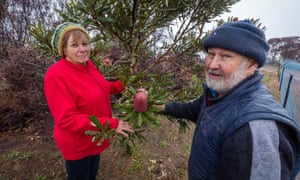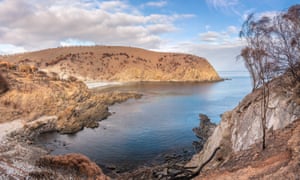Somewhere on Australia’s Kangaroo Island, a fledgling glossy black-cockatoo with identity number 0601 is laying down a new chapter in a remarkable survival story.
In early January this year, her panicked parents fled their nest in a gum tree at the edge of Carol and John Stanton’s garden to escape the smoke and flames of bushfires that were sweeping across a third of the island.
The Stantons lost their home to the fires, but the tree – and the nest – survived.
Q&A What is the After the Bushfires series?
Show
Hide
The wildfires that swept through many parts of Australia between July 2019 and February 2020 were of a scale and size that is difficult to imagine. By the end of February, they had burned through at least 32,000 square miles (85,000 sq km) of Australian forest, an area the size of Ireland.
Nearly 3 billion animals were killed or displaced by bushfire. The habitat of an estimated 143 million mammals, 180 million birds, 51 million frogs and 2.5 billion reptiles was burned.
The fires came during Australia’s hottest year on record and in a country that already has among the world’s highest extinction rates because of invasive non-native species such as cats, foxes, deer, horses and various pathogens, along with habitat clearing and fragmentation.
But one year on from the start of those fires, what does the landscape look like today? With state borders closing because of Covid-19, the Guardian took a virtual journey through the blackened path of Australia’s summer of bushfires, talking to those who are investigating the state of the continent’s surviving flora and fauna.
In the weeks that followed, as the couple set about cleaning up, they were amazed to discover that the pair had not only returned but were accompanied by the shrill squawk of a nestling.
“That was really special and it just made you thankful they survived. It gave us a lift,” says Carol.

Glossies, as they’re called, pair up for life and the Stantons had been watching the two birds visit the artificial nest made from adapted storm drain piping at the edge of their garden, a tourist attraction on the island off the state of South Australia, for years.
“There’s a track under the tree,” says Carol. “They’re a very gentle bird – you do get attached to them. They would come out and look at us – they just became used to us being there. For the same pair to use that same nest year after year, it’s a real pleasure for us.”
The island’s glossies are a unique subspecies that conservationists have been working for 25 years to save. They feed only on the seed cones of one tree – the drooping sheoak – and lay only one egg a year. To the Stantons it seemed remarkable their glossies had not only produced an egg but that it had thrived to become 0601.
Even as the fires raged, “that pair would have been there going through the courtship rituals”, says Mike Barth, who manages the island’s conservation programme to save the birds from extinction.
As fire authorities continued to release new maps of burnt areas on the island, Barth says he “would cringe as we just lost another nesting site”.
But on 11 February, while Barth was surveying the damage and checking on what nests remained, he saw the female in the Stantons’ garden sitting on an egg. On 29 April, while the parents were out finding food for their newest family member, he climbed up to the nest and attached the stainless steel band with number 0601 on it to the nestling’s leg.
Despite this success story, Barth says: “We don’t really know at this stage how many birds we lost. We think we did lose some directly in the fires.” Barth will help take a census of the birds later this year.
In the mid-90s, there were just 158 glossies left. The clearing of land for development and agriculture had increased the numbers of native possums that like to invade cockatoo nests and steal the eggs.
But conservation efforts to guard hollows from possum raiders, install artificial nests and plant more sheoaks saw numbers get as high as 400 before the fires came through.

“It was mind-blowing, the extent of the area burned,” Barth says. “Just driving on and on westward and seeing all these places and it’s not just the glossy black habitat, but all the people I know who had lost their homes. It was heartbreaking to see it.
“I was dumbfounded how many large old-growth trees were lost. The fire had got into the base and just toppled them.”
Number 0601 is hopefully out there with the 33 other new fledglings counted since the fires, avoiding birds of prey and finding the odd unburned sheoak tree here and there.
“We have lost a huge number of feed trees out west,” says Barth. “Every green tree counts, is what I keep saying.”
Even though the sheoaks can cope with fire and some are resprouting, it will be five to 15 years before there are seeds growing again for the birds to feed on.

But Barth is hopeful. “They’re smart birds and the way I see it is that they have a little mind map of feed trees and once they’ve found one, they’ll keep coming back to it year after year.
“We have a planting [of sheoaks] near Stokes Bay that survived the fire. Those trees are only four or five years old so in two more years they’ll have seeds.”
In the back of everyone’s mind on the island, says Barth, is the threat of more fires in the years to come. “Next year it could be the east end of the island – we just don’t know,” he says.
“Humans have tipped the balance for a lot of species and it’s our responsibility to do something to help them. We created the conditions. I’m happy to be one out there helping out.”
Find more age of extinction coverage here, and follow biodiversity reporters Phoebe Weston and Patrick Greenfield on Twitter for all the latest news and features